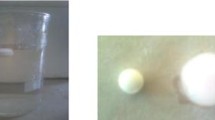Abstract
Labetalol hydrochloride (LBT), 2-hydroxy-5-[1-hydroxy-2-[(1-methyl-3-phenylpropyl) amino] ethyl]-benzamide, a non-selective α, β-adrenoceptor antagonist is used in the treatment of hypertension. It shows variable bioavailability ranging from 10–80% which may be attributed to its minimum solubility in pH range 6 to 10, the pH conditions prevailing at the major site of absorption i.e. small intestine. Also due to its half life of 3 to 6 hrs it is administered twice daily. In the present work non-effervescent sustained release gastroretentive floating tablets of labetalol hydrochloride have been developed using various grades of HPMC and Poloxamer M127 as wetting agent. The tablets were evaluated for in vitro drug release, floating time, floating lag time, swelling studies etc. The tablets formulated with HPMC K4M CR and HPMC K15M CR along with Poloxamer showed negligible floating lag time with a total floating time over 12 hrs with complete release. Formulation was optimized using Stat-Ease Design Expert 7.1 software. Optimized batch was evaluated for the effect of change of osmolarity and pH on drug release, floating and swelling behaviour.
Similar content being viewed by others
References
Ansel, H., Stoklosa, M., Pharmaceutical Calculations, 11th edn, Lippincott, Williams and Wilkins, Baltimore, MD, pp. 178–180, (2001).
Arora S., Ali J., Ahuja A., Khar R. K., and Baboota S., Floatimg drug dellivery systems: A Review. AAPS PharmSciTech, 6, 47 (2005).
Baumgartner, S., Smid-Korber, J., Vreces, F., and Kristl, J., Physical and technological parameters influencing floating properties of matrix tablets based on cellulose ethers. STP Pharma. Sciences, 8, 182–187 (1998).
Dollery, C., Therapeutic drugs. Volume 1, IInd edition, Churchill Livingstone, L1–L3 (1999).
Gutierrez-Rocca, J., Omidian, H., and Shah, K., Progresses in gastroretentive drug delivery. Pharm. Tech., 152–156 (2003).
Jain, N. K., Novel Drug Delivery Systems, 2nd edition, Revised and expanded, CBS Publishers Delhi, pp. 1–42, (2004).
Martes, L., In: Handbook of Analytical Chemistry (eds) Mcgraw Hill, New York, pp. 329, (1963).
Nur, A. O. and Zhang, J. S., Captopril floating and/or bioadhesive tablets: design and release kinetics. Drug Dev. Ind. Pharm., 26, 965–969 (2000).
Rosa, M., Zia, H., and Rhodes, T., Dosing and testing in-vitro of a bioadhesive and floating drug delivery system for oral application. Int. J. Pharm., 105, 65–70 (1994).
Srivastava, A. K., Wadhwa, S., Ridhurkar, D., and Mishra, B., Oral sustained delivery of atenolol from floating matrix tablets formulation and in vitro evaluation. Drug Dev. Ind. Pharm., 31, 367–374 (2005).
Timmermans, J. and Moes, A. J., How well does floating dosage forms float. Int. J. Pharm., 62, 207–216 (1990).
Wu, W., Zhou, Q., Zhang, H. B., Ma, G. D., Fu, C. D., Studies on Nimodipine sustained release tablet capable of floating on gastric fluids with prolonged gastric resident time. Yao Xue Xue Bao., 32, 786–790 (1997).
Author information
Authors and Affiliations
Corresponding author
Rights and permissions
About this article
Cite this article
Garse, H., Vij, M., Yamgar, M. et al. Formulation and evaluation of a gastroretentive dosage form of labetalol hydrochloride. Arch. Pharm. Res. 33, 405–410 (2010). https://doi.org/10.1007/s12272-010-0309-z
Received:
Revised:
Accepted:
Published:
Issue Date:
DOI: https://doi.org/10.1007/s12272-010-0309-z




